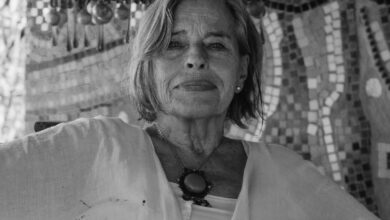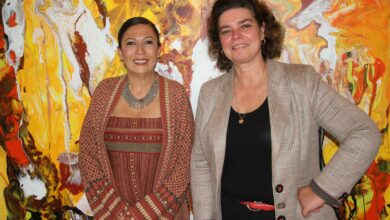A project of the Swiss Arts Council Pro Helvetia’s Artists in Residence program, Where Are You? is a contemporary art exhibition of the work of 20 artists from Lebanon, Jordan, Egypt and Switzerland. They all spent time out of their homelands in residency abroad, which helped their production processes and from which Where Are You? is the offspring.
Where Are You? interrogates the conditions of production under the banner of cultural exchange. How is culture experienced on an everyday level? How does it interact and/or conflict with the visiting artist’s own cultural baggage? And how does this space of both interaction and conflict become conducive to the formation of identities of passage, which usually exhibit traits of constant questioning and quests for the engagement of the “other”?
The resulting artworks managed, at different levels, to address those propositions. While some remained solely expressions of self-examination, others managed to branch out and establish a measure of interaction with those who could identify. Scattered strategically around the corners of the Townhouse Gallery of Contemporary Art’s first floor, factory space and their outdoor areas, the neutrality of the gallery space is broken, enabling the viewer to constantly re-imagine the spaces according to the aims of the artists.
An example of a process originating in the imagination then wittingly communicated through the exhibition is Another Member. Ziad Bitar and Nayla Dabaji, a Lebanese artist duo, developed a fictitious flag, dubbed the Union of West Asia. They then took the flag to different demonstrations they attended during their stay in the Swiss city of Bern. By doing so, they provoked questions pertaining to political signs and perceptions, which were not far from the contentions of defining national identity they face as Lebanese nationals. By being a creation of their imagination, the fictitious flag became just another bypassed member in the mass of demonstrators, thus contesting the firmness with which a passionate nationalist would define their identity. Bitar and Dabaji photographed their interventions in demonstrations and hung them on thin threads in one exhibition corner, possibly to further elucidate notions of floating identities.
Swiss artist Nadja Solari presented Sincerely Yours in an attempt to examine questions of the public and the private. In an instance of public intervention, we see on the rough un-painted outer wall of a nearby building a series of digits illuminated with red light. The digits coincide as obscure Latin inscriptions with a mishmash of advertisement on the wall of a regular Cairene alley busy with the motions of a baladi coffeehouse and many mechanics’ workshops. Solari’s digits are that of her Swiss account number, a piece of information usually considered private and confidential. But they are also an unquestioned marker of Switzerland, a nation associated with banks and money. Solari questioned established identity binaries: Where is the individual in the collective and what is private that can go public? The level of interaction she established in a Cairo street was qualified by the remoteness of her digits and the possibility of engaging with them. Yet one wonders what this presence in the street could prompt in terms of responses; what could a passerby make of those digits? Could they go about looking for the proprietor of the account? Could someone take it a step further and send her money?
In Return to Sender, Swiss artist Ken Seller fished more deliberately for responses. He produced a series of stamped postcards based on street photography in Cairo. In the exhibition space, he set up a small stage, where he placed a stand with his postcards, a small seating area with a pen and a box where the postcards would be returned after being written. Seller created a condition of interaction whereby visitors once gathered around his stage become doers; they spend time selecting a postcard and writing it. One visitor selected a postcard with a photo of a street-based amusement park in Cairo and wrote on its back, “Cairo is so sad today.” She put the card in the box and left wondering what Seller would do with all the cards. A second stage of Return to Sender was thus needed, as its influence in the process of interaction remained limited.
Egyptian artist Haytham Nawar opted for a realistic tone by presenting art as “selective re-creation of reality.” In his 10-minute video installation 31/49, he rode two bus lines repeatedly, one in Zurich, numbered 31 and the other in Cairo, numbered 49. Both bus lines travel across the overtly socially-diverse cities, taking him from their richest neighborhoods to their poorest. Both cities unveil themselves in the daily bus trip, where diverse passengers represent the multi-layered social landscape. Between the workers and migrants quarter of Schlieren and the affluent district of Hegibachplatz in Zurich on the one hand and the chaotic square of Attaba leading to the posh Nile island of Zamalek in Cairo on the other, Nawar seems to have embraced what has become a conventional and somewhat exhausted position: caught in the middle of two cultures, at the crossroads of different societies. The highlight of 31/49 is, however, the form in use and its function in portraying the issue at hand; the bus is an everyday relic that easily registers in the minds of gallery visitors. While not being a static piece of reality and remaining a mere connector between established destinations, it could still host a profound three-dimensional take on the city.
Beate Engel, the Swiss curator of Where Are You? spoke about the artists of the show as “creative mediators in a world of confusion and disorientation.” The resulting show is indeed an active and genuine process of intellectual inquisitiveness presented on the plate of alternativeness that conceptual art offers. Its curatorial concept is rather mild and more concerned with highlighting experiences of artists-in-residence. While the artworks stir consistently pressing issues of identity, they maintain, in the background, a major persisting question: how conceptual art can be a tactical tool in our understanding of the world.
Where Are You?
Townhouse Gallery of Contemporary Art
10 Nabarawy Street , Off Champollion Street, Downtown
November 1- 22, Opening times: Daily 10-2 AM 6-9 PM
Closed on Thursdays




